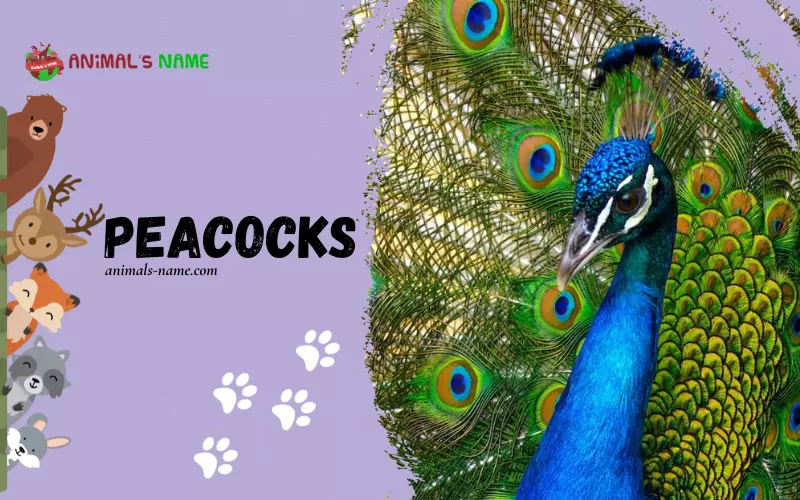Join us in celebrating National Peacock Day on March 25th, a vibrant occasion dedicated to honouring the magnificence of these animals’ names. Did you know that peacocks, known for their stunning, iridescent feathers, offer more than just a visual treat?
In this blog post, we’ll take a deep dive into the realm of these majestic creatures, from their captivating appearance to their intriguing behaviours. You’ll gain insights into why people hold these animals names dear, appreciating their dazzling plumage and cultural and ecological significance.
So, prepare to unfurl the wings of your knowledge as we embark on a journey into the world of peacocks and uncover the reasons behind their widespread admiration throughout the United States and across the globe. I wish you a joyous National Peacock Day on March 25th!
Physical Characteristics of Peacocks
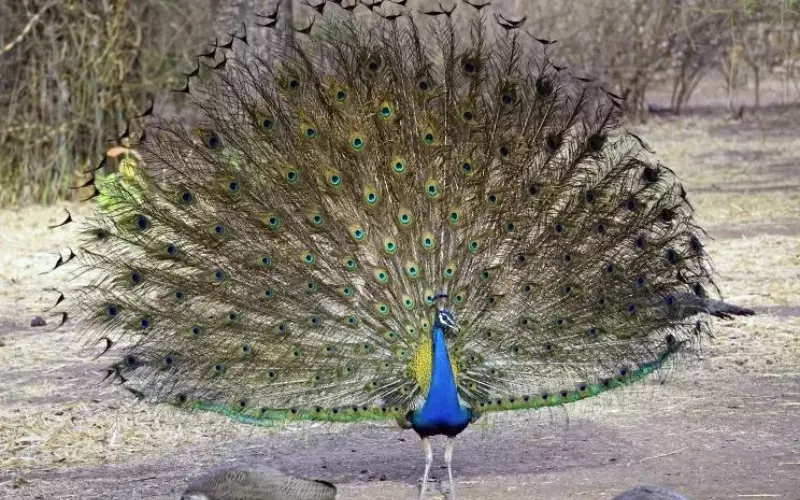
Peacocks, known for their striking appearance, boast a range of physical characteristics that make them truly captivating creatures:
- Plumage: The male peacock’s most iconic feature is its stunning plumage. The iridescent feathers mix vibrant hues, including electric blues, emerald greens, and shimmering bronzes. When fully displayed, the feathers form a magnificent fan-shaped train reaching up to six feet long.
- Crest: Atop the peacock’s head is a regal crest of feathers that can be raised or lowered to express emotions or signal territorial displays.
- Body: Peacocks have relatively large, muscular bodies with prominent necks and slender, elegant waists.
- Size: Males, known as peacocks, are generally larger than females, known as peahens. Peacocks weigh 8 to 13 pounds, while peahens weigh around 6 to 9 pounds.
- Tail Feathers: The striking tail feathers of a peacock, known as “coverts,” are the elongated feathers that support the train. They are essential for courtship displays and play a significant role in attracting mates.
These physical attributes collectively contribute to the peacock’s remarkable beauty, making it a beloved symbol of grace and elegance in nature.
Different Types of Peacocks
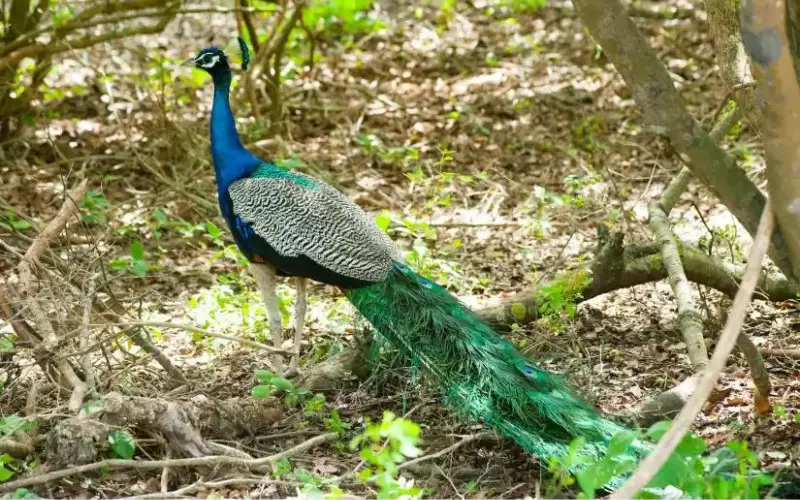
The most commonly encountered peafowl in the United States are generally derived from the Indian Peafowl species (Pavo cristatus). However, within the Indian Peafowl species, there can be variations in color and patterns. Here are some of the common types you might find:
- Indian Blue Peafowl: These are the most prevalent type in the United States. Males have the classic iridescent blue-green plumage with striking “eye” patterns on their long tail feathers. Females are typically brown and green.
- White Peafowl: These are a colour variation of the Indian Blue Peafowl. They have pure white feathers instead of the traditional blue and green. White peafowls are highly prized for their unique appearance.
- Black-Shoulder Peafowl: These peafowls have a genetic variation that causes the blue and green colours of the males to be replaced with shades of brown. They have black markings on their shoulders, hence the name.
- Opal Peafowl: Opal peafowls are a relatively rare colour mutation in which the usual blue and green feathers are replaced with pastel shades, including lavender and pink. They have a soft and delicate appearance.
- Pied Peafowl: Pied peafowls have a mixture of white and coloured feathers. They can vary in the extent of white versus coloured plumage, creating a unique and eye-catching pattern.
The three types of peafowl, Indian, Green, and Congo, are remarkable examples of nature’s beauty and diversity. From the resplendent Indian peafowl to the subtle elegance of the Congo peafowl, each type adds to the allure and wonder of these enchanting birds.
Human-Peacock Interactions
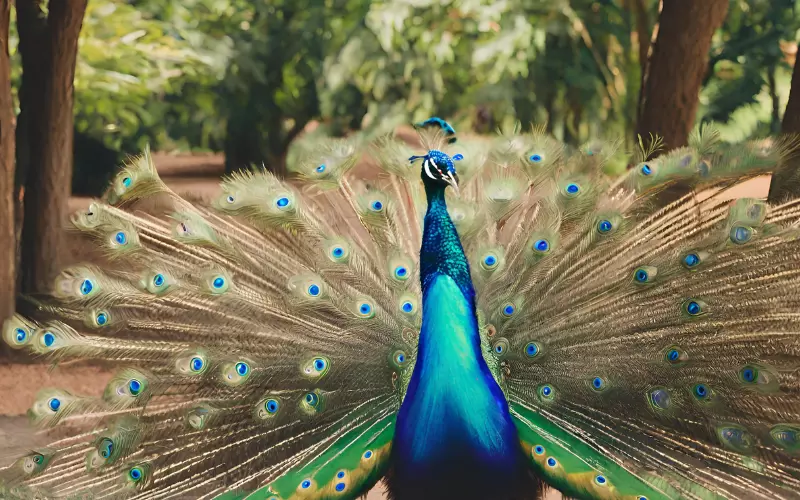
Cultural, artistic, and ecological influences have shaped human-peacock interactions. Here are some aspects of how humans and peacocks interact:
- Cultural Significance: Peacocks hold immense cultural significance in many societies, often symbolizing beauty, royalty, and spirituality. They are featured in art, literature, and religious ceremonies, cementing their place in human culture.
- Tourist Attractions: In regions where peacocks roam freely, they have become tourist attractions, drawing visitors eager to witness their dazzling displays and graceful movements.
- Feeding and Domestication: In some areas, people feed and interact with peacocks, leading to partial domestication in specific settings like parks and gardens.
- Ecological Impact: Human activities, such as deforestation and urbanization, can affect peacock habitats and food sources, impacting their populations.
- Conservation Efforts: In response to threats faced by peacocks, various conservation initiatives have been undertaken to protect their habitats and promote sustainable coexistence.
Human-peacock interactions are a fascinating blend of cultural admiration, ecological considerations, and conservation efforts, underscoring these magnificent birds’ enduring fascination and importance in our shared world.
Peacocks in Art, Literature, and Fashion

Peacocks have left an indelible mark on art, literature, and fashion, inspiring creativity and admiration across various mediums:
Art:
In paintings, peacocks are symbols of beauty, immortality, and spirituality, often depicted alongside deities or as standalone subjects. Their vibrant plumage and graceful demeanour have been captured in sculptures, ceramics, and mosaics, adding elegance to artistic creations. Peacock motifs and patterns have adorned architecture, textiles, and decorative arts, showcasing their allure in diverse cultural aesthetics.
Literature:
Peacocks have been celebrated in poetry, with their magnificent feathers becoming metaphors for beauty and grace. They appear in folklore and fairy tales, embodying transformation, pride, and mystical allure themes. Peacocks are referenced in ancient epics and religious texts, representing various virtues and divine qualities.
Fashion:
The peacock’s iridescent colours have influenced fashion design, inspiring clothing, accessories, and haute couture. Peacock feather motifs have been incorporated into fabrics, embroidery, and jewellery, elevating the aesthetics of fashion creations. Peacock-themed collections have graced runways, reflecting the bird’s elegance and allure in modern fashion.
The beauty of peacocks has transcended time, captivating human imagination in art, literature, and fashion, making them timeless symbols of grace and splendour in creative expressions worldwide.
Interesting Facts About Peacocks
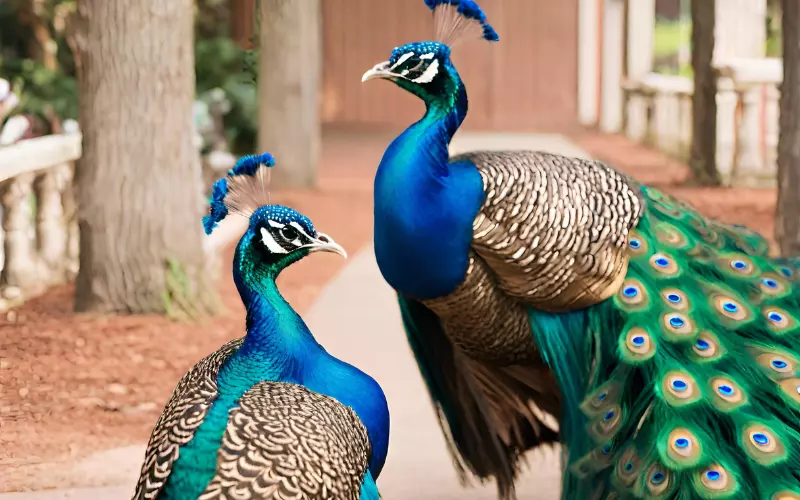
Dazzling Plumage: Peacock feathers are renowned for their vibrant colours and intricate patterns. The striking hues, including iridescent blues, greens, and gold, make them one of the most eye-catching displays in the animal kingdom.
- Courtship Displays: During mating season, male peacocks perform elaborate courtship displays to attract females. They spread their magnificent tail feathers into a fan-like shape and dance gracefully, creating a mesmerizing spectacle to impress potential mates.
- Males vs. Females: Male peacocks, known as peacocks, have impressive plumage, while female peafowls, known as peahens, have more subdued feathers, providing better camouflage during nesting.
- Peafowl Family: Peacocks belong to the pheasant family and are native to South Asia. There are three main types: the Indian peafowl, the green peafowl, and the Congo peafowl.
- Flying Ability: Despite their majestic appearance, peacocks are not strong flyers and generally prefer to stay on the ground, using their wings mainly for balance and short flights.
- Roosting in Trees: Peafowls roost in trees at night to protect themselves from predators. Their strong feet and talons help them grip tree branches securely.
Peacocks’ fascinating characteristics and stunning displays have captivated human fascination for centuries, earning them a special place in the natural world and human culture.
Conservation and Protection
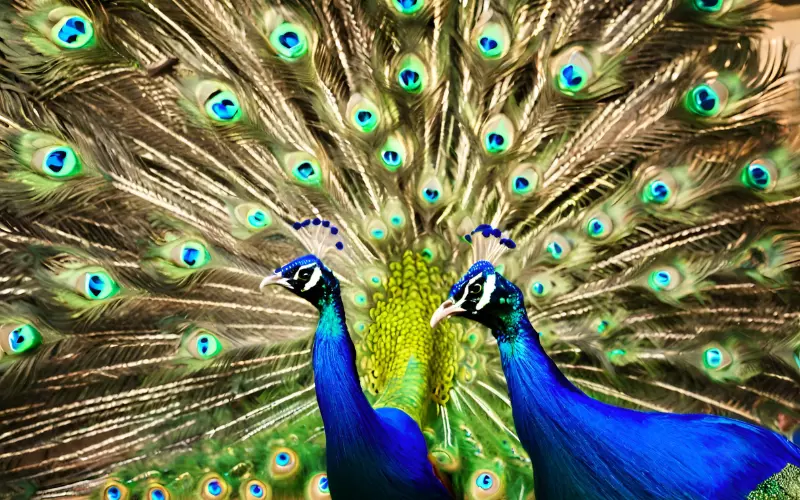
Conservation and protection efforts for peacocks are crucial to safeguarding these magnificent birds and their habitats. Here are some key initiatives and considerations:
- Habitat Preservation:
Preserving natural habitats, such as forests and grasslands, is vital for the survival of peacocks. Protecting these areas from deforestation and urbanization helps maintain suitable environments for peafowls to thrive.
- Wildlife Sanctuaries:
Establishing and maintaining wildlife sanctuaries dedicated to peacocks allows for focused conservation efforts, providing safe breeding, feeding, and roosting spaces.
- Anti-Poaching Measures:
Enforcing strict anti-poaching laws and penalties helps deter illegal hunting and trade of peacocks and their feathers, protecting them from exploitation.
- Community Participation:
Engaging local communities in conservation efforts fosters a sense of ownership and responsibility towards peafowls, encouraging sustainable coexistence.
- Education and Awareness:
Raising awareness about the importance of peacock conservation through educational programs and public campaigns promotes appreciation for these birds and their ecological role.
By implementing these conservation and protection measures, we can secure the future of peacocks, preserving their beauty, grace, and ecological significance for generations to come.
Peacock-inspired Symbolism in Modern Culture

Peacocks have profoundly impacted modern culture, inspiring symbolism in various art, literature, and popular media forms. Here are some ways peacock-inspired symbolism is evident in contemporary culture:
- Fashion and Design: The peacock’s vibrant plumage has become a popular motif in style and design, adorning clothing, accessories, and home decor. The mesmerizing colours and patterns add an element of elegance and allure to modern aesthetics.
- Television and Film: Peacocks have appeared in television shows and movies, representing beauty, confidence, and sometimes mystical qualities. Their symbolism is used to depict characters with enchanting or flamboyant traits.
- Social Media and Memes: Peacock-related memes and internet culture have emerged, playfully referencing the bird’s striking appearance and associating it with traits like confidence and flamboyance.
- Literature and Poetry: Authors and poets often use peacock symbolism to evoke imagery and emotions in their literary works. The bird’s striking beauty and courtship are metaphors for human experiences and emotions.
- Interior Design: Peacock-inspired themes are prevalent in interior design, with furnishings and home accessories featuring peacock motifs accentuating living spaces with a touch of luxury.
- Cultural Festivals and Events: Peacock imagery is incorporated into cultural festivals, events, and celebrations, symbolizing joy, abundance, and auspiciousness in diverse traditions.
Peacock-inspired symbolism continues to captivate modern culture, reflecting these majestic birds’ enduring allure and significance across various aspects of contemporary life.
Peacocks in Mythology and Folklore
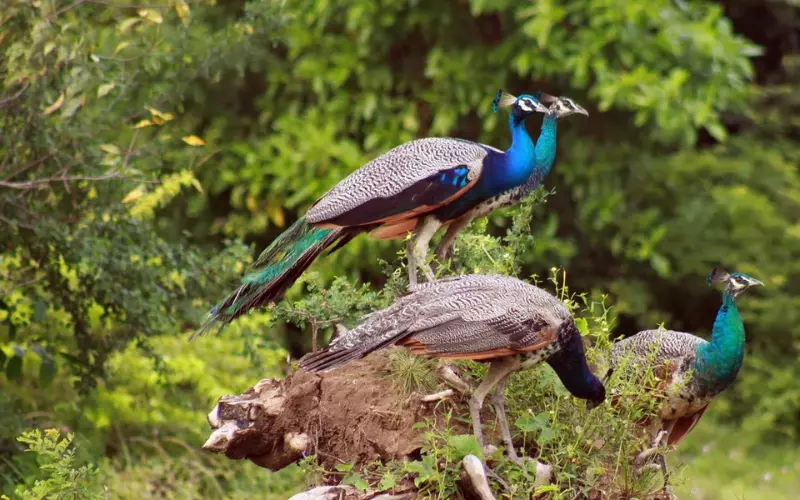
Peacocks have been revered in mythology and folklore worldwide. In Hindu mythology, they are associated with gods and considered symbols of grace and protection. In Greek folklore, peacocks are linked to the goddess Hera’s watchfulness.
Across cultures, their feathers are seen as symbols of beauty, immortality, and divine qualities. In Southeast Asia, peacocks carry souls to paradise, while in Chinese folklore, they represent dignity.
Historically, peacocks have been celebrated in art, literature, and religious stories, embodying various virtues and mystical allure. Their presence in myths and tales continues to inspire wonder and fascination, making them timeless symbols of grace and splendour in human culture.
30 Ways to Celebrate National Peacock Day
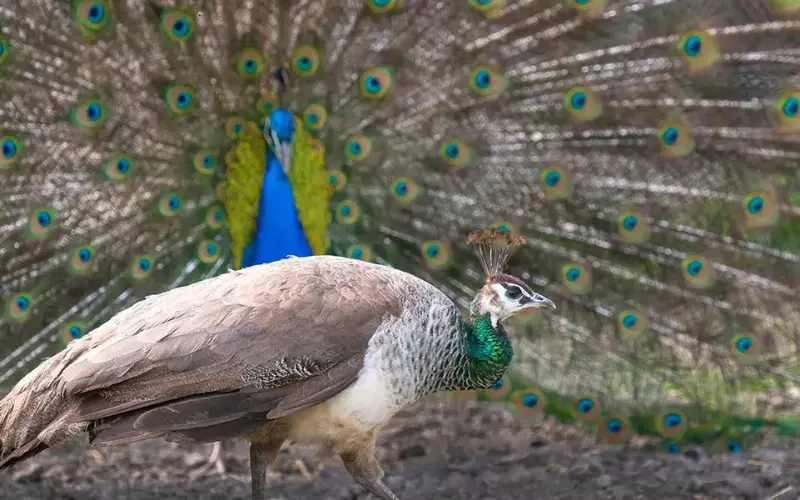
1. Visit a Zoo: Spend the day at a zoo to see peacocks up close.
2. Learn About Peacocks: Read books or watch documentaries about these beautiful birds.
3. Art Project: Create peacock-themed art, such as paintings or drawings.
4. Craft Feathers: Make crafts using peacock feathers.
5. Dress Up: Wear peacock-inspired clothing or accessories.
6. Visit a Peafowl Sanctuary: If available, visit a sanctuary dedicated to peafowls.
7. Picnic: Have a picnic with friends and family in a park or garden where peacocks roam.
8. Visit a Botanical Garden: Many gardens feature peacocks among their attractions.
9. Photography: Capture the beauty of peacocks through photography.
10. Peacock Dance: Try imitating the dance of a peacock.
11. Bake Peacock-Themed Treats: Make peacock-shaped cookies or cakes.
12. Bird Watching: Go birdwatching and try to spot peafowls in the wild.
13. Peacock Jewelry: Wear or make jewellery inspired by peacock feathers.
14. Donate to Conservation: Contribute to organizations that protect peafowls and their habitats.
15. Peacock Gardens: Create a peacock-themed garden with plants and decorations.
16. Visit a Museum: Check out art or natural history museums with peacock exhibits.
17. Peacock Feeding: Feed peacocks at a local park or sanctuary if allowed.
18. Storytime: Read stories about peacocks to children.
19. Virtual Tours: Take virtual tours of places known for their peacock populations.
20. Listen to Peacock Calls: Learn about the different sounds peacocks make.
21. Peacock-inspired Makeup: Experiment with peacock-themed makeup looks.
22. Support Local Artisans: Buy peacock-themed products from local artisans.
23. Nature Hike: Go on a nature hike and watch for peafowls.
24. Share Peacock Facts: Share exciting facts with friends and family.
25. Birdhouse Building: Create a birdhouse that resembles a peacock.
26. Watch Peacock Videos: Enjoy videos of peacocks displaying their vibrant plumage.
27. Peacock-themed Puzzles: Solve puzzles featuring peacock images.
28. Plant Peacock-friendly Plants: Plant flowers and shrubs that attract peacocks.
29. Peacock-themed Music: Listen to music inspired by peacocks or their habitat.
30. Share on Social Media: Share your peacock-themed activities on social media with #NationalPeacockDay to raise awareness.
Conclusion
National Peacock Day is filled with wonder and admiration for these incredible birds. While it may not be an official holiday in the United States, it’s a perfect time to appreciate the beauty of peacocks and learn more about them. These birds, with their stunning feathers and graceful dances, remind us of our planet’s amazing diversity of wildlife.
Whether you visit a zoo, create peacock-inspired art, or take a moment to marvel at their elegance, National Peacock Day is a chance to connect with nature’s wonders. Let’s celebrate these majestic birds and remember to protect and preserve their habitats so that future generations can continue to be inspired by their beauty. Happy National Peacock Day!
FAQ’s
Q: Why is the peacock a national bird?
A: Peacock is India’s national bird due to its cultural significance and vibrant beauty.
Q: Who declared the peacock a National Bird?
A: The Indian government officially declared the peacock the national bird in 1963.
Q: What is the age of peacock in India?
A: Peacocks can live up to 15-20 years in the wild.
Q: What is peacock history in India?
A: Peacocks have been admired in Indian culture for centuries, symbolizing grace and beauty.
Q: Why is the peacock a symbol of India?
A: Peacocks are associated with India’s rich cultural heritage and are admired for their beauty.
Q: What are five interesting facts about peacocks?
A: Vibrant plumage, courtship dances, native to India, impressive tail, and loud calls are peacock traits.
Q: What is the importance of peacock?
A: Peacocks are important for biodiversity and cultural significance.
Q: In which state peacock is found?
A: Peacocks are found across India but are the state bird of Rajasthan.
Q: Is the peacock the king of birds?
A: Some cultures consider peacocks as symbols of royalty, but it’s not the king of birds.
Q: What is the famous line of peacock?
A: The peacock’s fan-shaped tail is its most famous feature.
Q: Is the peacock a Hindu symbol?
A: Yes, peacocks have religious significance in Hinduism.
Q: Why are peacocks protected in India?
A: To conserve their population and protect their cultural importance.
Q: Which city is famous for peacocks?
A: Jodhpur in Rajasthan is known for peacock sightings.

Hi there, I’m Emily Buono, and I’m thrilled to introduce myself! Currently, I’m part of two fantastic places: I work as a VisEx at the New England Aquarium and as an RAS at MGH CCM.
I completed my education at the Mass General Research Institute and Stonehill College, which is located in Valatie Colony, New York, in the United States.
Now, here’s the exciting part: I absolutely adore animals! They captivate me, and I’m always eager to learn more about them. In fact, I write articles all about these incredible creatures.
In the past, I’ve worn many hats, such as being a biologist at the Maria Mitchell Association, a cashier, a floor organizer, and a visitor experience and research animal specialist.
My passion lies in exploring the world of animals and helping others understand them better. So, if you ever have questions about animals, feel free to reach out. I’m here to make animal info easy and fun to grasp!

